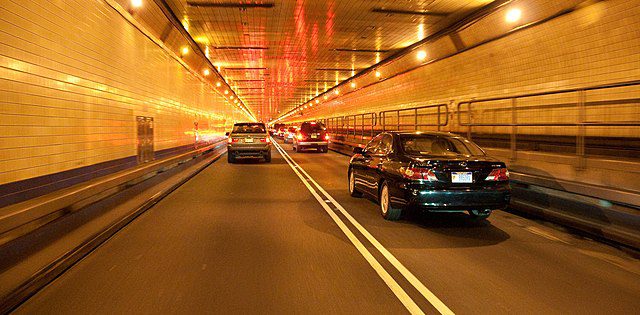Transportation, AFFORDABLE PLACE TO LIVE
What NYC’s Congestion Pricing Means for New Jersey

With the recent approval from federal transportation officials, New York City is poised to become the first city in the United States to implement a congestion pricing plan that will charge drivers entering lower Manhattan as early as Spring of 2024.
While this plan is hailed as a solution for traffic congestion, air pollution, and investment in transportation infrastructure, what the congestion plan fails to take into account is that these extra taxes will affect everyday commuters from throughout the five boroughs as well as surrounding states. In 2017, it was estimated that there were 973,000 commuters per day traveling back and forth from New York City, with 42% of those commuters coming from various counties in New Jersey; this is projected to increase by 10% by 2030. In addition to the regular tolling on the Lincoln and Holland Tunnels, commuters will need to pay the congestion pricing fee, for the tunnels end right in the designated zone. According to the Port Authority, between the months of January and May of 2023, an average of 1,574,000 vehicles used the Lincoln Tunnel per month and an average of 1,278,000 vehicles used the Holland Tunnel per month. The New York Metropolitan Transportation Authority (MTA) has not released the exact fees to be charged per vehicle, but one initial plan imposed a $23 fee for cars entering the area south of 60th Street during rush hour and $17 for entering the area during “off hours.” Proponents of this plan, including New York Governor Kathy Hochul, believe that it will help to reduce traffic, fund the MTA for more projects, and decrease air pollution in the city. New York proponents ignore how this will impact many commuters and families in New Jersey.
Governor Murphy, Senator Bob Menendez, Representative Josh Gottheimer, and Representative Mikie Sherrill are strong opponents of this plan, citing the harm it will cause to New Jerseyans. With the fees imposed, the traffic flow will be rerouted, and many commuters will begin to drive through Northern New Jersey, specifically Bergen County, and the outer boroughs of New York City, increasing air pollution to those areas. While the MTA has set aside a budget for the effects of air pollution in the Bronx and other boroughs, Gottheimer claims that there is “not a nickel for New Jersey.” Congestion pricing will not, overall, decrease air pollution; instead, it will push the problems and burdens of pollution into New Jersey and the areas outside of the specific zone in lower Manhattan south of 60th Street. This begs the question- why are the emissions from a vehicle on 61st street any less harmful than a vehicle on 59th street?
New Jersey representatives want a more comprehensive environmental impact assessment on not just New York, but New Jersey, as well. If this is granted, it will set an example for other states to collaborate on policy solutions to environmental pollution, instead of neglecting the impacts of neighboring states.
The question remains- does congestion pricing reduce emissions? Most emissions in lower Manhattan are a result of delivery trucks. In effect, imposing this tax on delivery trucks will have the largest financial impact on small businesses located in New York City. Mom and Pop stores will struggle to stay in business; a staple of communities both economically and socially.
Representative Josh Gottheimer has proposed a “Stay in Jersey” campaign to counter these effects. This would be a tax incentive for New York City businesses to open up regional business centers in New Jersey, so New Jersey employees will not have to pay the taxes to travel into the city and to attract more businesses into New Jersey. A bipartisan effort is currently underway, with legal actions against New York ensuing, as well as the STOP NJ CONGESTION Act proposition introduced by Senator Menendez and Representatives Pascrell and Gottheimer. Many other representatives in the U.S. House of Representatives are co-sponsors to this legislation, such as Tom Kean, Jr., Jeff Van Drew, Frank Palone, Bonnie Watson Coleman, Chris Smith, Mikie Sherrill, Rob Menendez, Jr., and Donald Norcross. This act “would impose highway sanctions on any state that implements the program described in the final Environmental Assessment for the Central Business District Tolling Program,” causing large transportation funding losses. The purpose is to deter New York officials from continuing further with this congestion pricing program and prompt New York lawmakers to consider the financial and environmental burden placed on New Jerseyans. Additionally, this act would require the approval of New Jersey for the project.
New York City is not the first major metropolitan city to implement a congestion pricing plan. Singapore, London, and Stockholm are notable examples in which a pricing plan has been implemented. However, the New York City congestion pricing plan is unlike these cities, therefore, will not result in similar outcomes. Singapore’s congestion pricing system has been around for 50 years and is different from the one being proposed for New York. Singapore ran into many issues, including a flat fee, which did not take into account vehicles making multiple trips to that area in a single day. Singapore saw that the congestion pricing resulted in more traffic and congestion outside the set boundaries. Therefore, the current plan in Singapore does not use flat fees and, instead, considers the location, type of vehicle, number of passengers, and speed of vehicle, amongst other factors.
London is also a prime example of congestion pricing. The main reason congestion pricing works in London is because of an efficient, centralized public transportation system. New York, on the other hand, has many different agencies involved in its complex transportation system, including those from different states, like NJ Transit or the PATH. Coordination of multiple agencies increases the complexity and cost of implementing a fair congestion pricing system. Overall, while Singapore and London have honed their congestion pricing plans over the years, New York would not share the same results.
To stop or improve the congestion pricing plan, New York and New Jersey would need to work together to come up with a fair solution for all residents and commuters of both states. This solution would need to begin with the investments and funding in improving both New Jersey’s and New York’s public transportation systems to become a more coherent and effective way of travel, like the system set up in London. With better funding to both states’ transportation systems, they could work together in a more centralized fashion to simplify transportation for the commuters. Funding to New Jersey transportation would allow for more access to residents in transportation deserts, as well as higher capacity to transport more passengers on lines such as the PATH and NJ Transit during rush hour. Because this affects both New York and New Jersey, instead of the MTA, Port Authority, an agency that involves the two states, should be running the congestion pricing to ensure a cooperative plan. With collaborative improvements to both states’ agencies, a more cohesive system could be set in place to facilitate travel and improve the congestion pricing plan.
For the fiscal 2024 year, New York plans to provide $9.4 billion for operating aid to its mass transit system, with the MTA receiving $8.5 billion of the aid (91%). In addition to this aid, the MTA will also receive an extra $305 million to help combat the effects from COVID on public transportation. With this budget increase, New York City can focus on improving and investing more into their bus and subway lines, making public transport an easier option at no extra cost to the commuter. Why, then, would New York City need the extra $1 billion the congestion pricing plan is proposed to procure?
Furthermore, the system implemented in Stockholm expanded their bus services and added more parking spaces outside of the city, allowing for more options for drivers. Stockholm has set a great example for providing a comprehensive plan, besides just taxes, to improve the lives of commuters, the city’s transportation, and its carbon emissions. Overall, the New York City congestion pricing plan is just a tax on commuters and nothing more.
The author is a member of GSI’s Summer Inernship program and is a student at the University of Wisconsin-Madison majoring in International Studies with a specialization in Global Security. She is a resident of Berkeley Heights , New Jersey.

